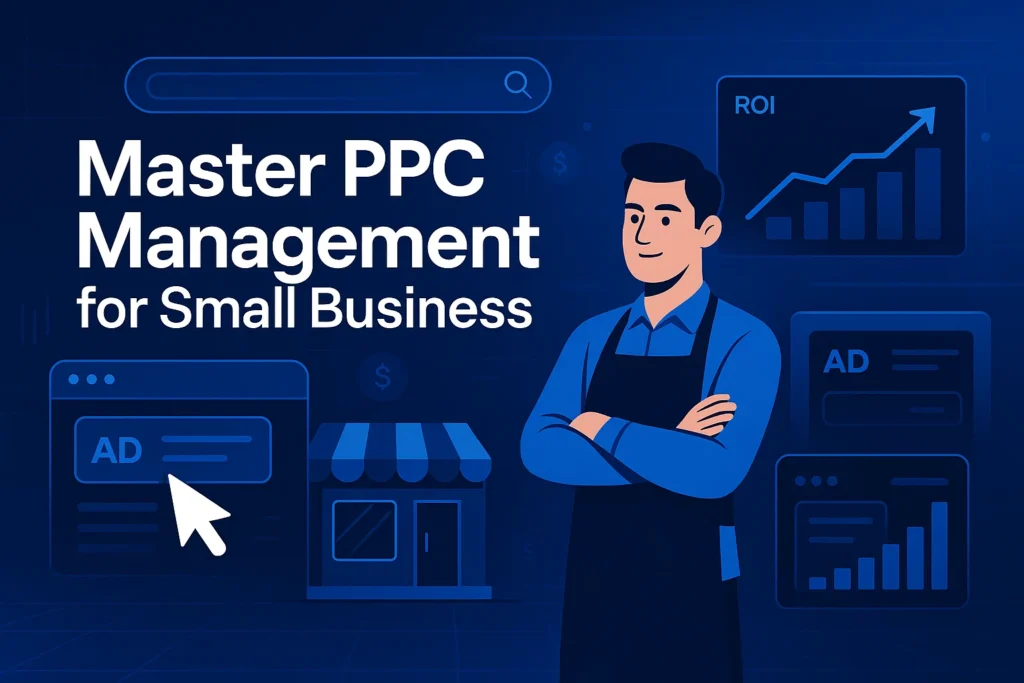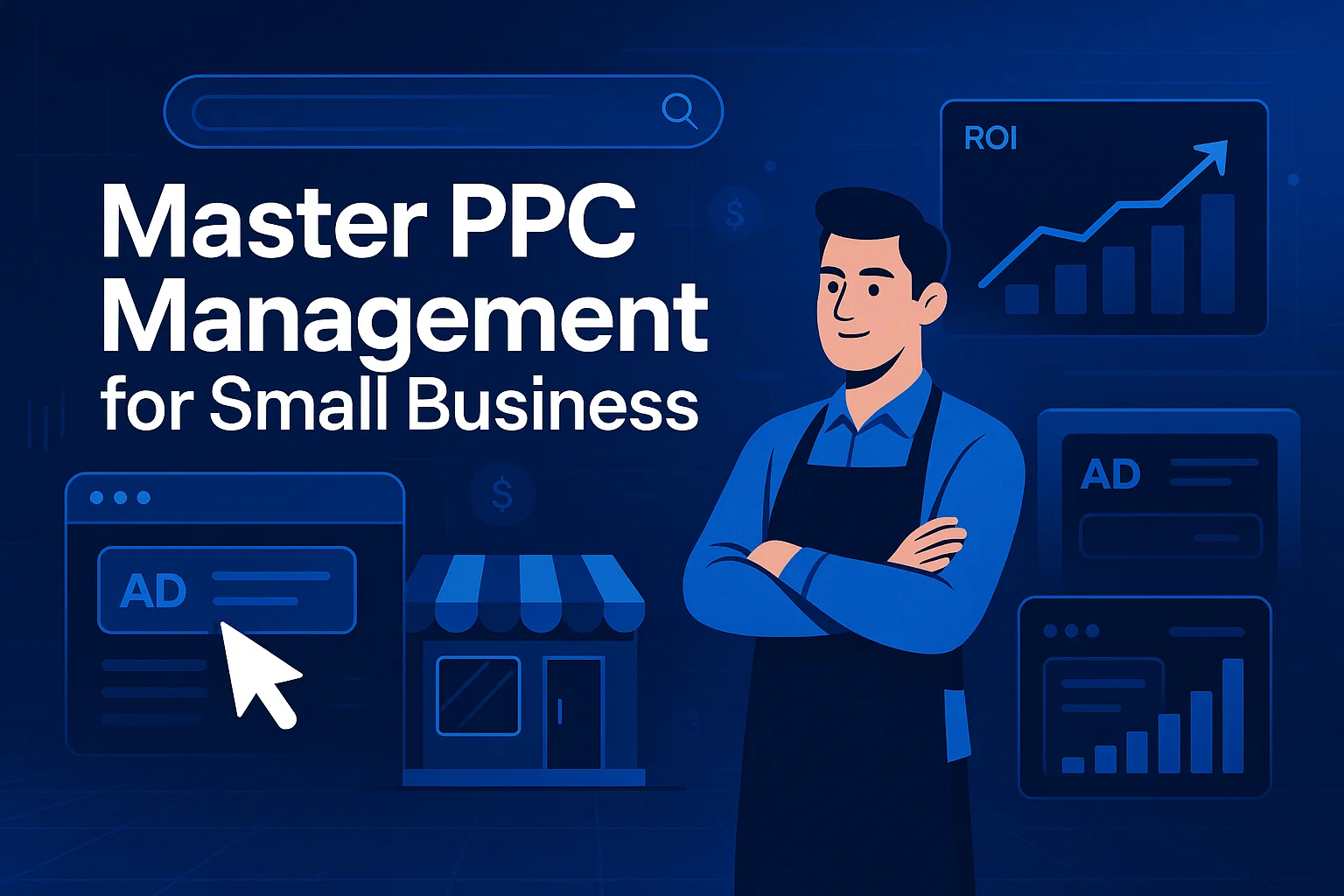“Struggling to get noticed online as a small business?” In this fast-paced world, when you have a limited marketing budget and are competing with other brands, looking for visibility on the first page can seem nearly impossible to achieve. But you are not alone. PPC (Pay-Per-Click) Advertising for small businesses allows you to present your business in front of high-intent customers for ranking and sales, even with a small budget. The real advantage? You only pay when someone clicks, meaning every dollar has the potential to drive real results. In this guide, in this guide you’re going to learn how to create and scale PPC campaigns for small business success. Whether you are new to online ads or trying to get a better return on your ad spend, learn how to create better targeted ad campaigns to maximize ROI.
What Is the PPC Model of Advertising?
Pay-Per-Click (PPC) Service is an online advertising model where you only pay when someone (users) clicks on your ad to reach your website, looking for certain products or services. The interesting factor is that PPC ensures you’re only charged when someone shows real interest by clicking. That’s why it’s ideal for small businesses, providing measurable results. PPC gives small businesses a powerful way to appear at the top of search engines (Google, Bing), social media feeds, partner sites, or Google’s Display Network without waiting months for organic rankings. PPC also includes other platforms like:
- Google Ads
- Microsoft Advertising (for Bing search ads)
- Meta Ads (for Facebook and Instagram)
- LinkedIn Ads, Pinterest Ads, and more
When done right, it gives you a scalable way to grow. The cost of a click is small compared to the lifetime value of a new customer, even on a tight budget.
PPC vs SEO: Understanding the Difference
When it comes to digital visibility, PPC marketing is different from Seo (Search Engine Optimization). Although both are types of Search Engine Marketing, they aim to drive direct traffic from search engines. However, their methods, timelines, and costs are very different. But these two can work together for a successful online growth.
PPC: It delivers immediate visibility by placing your ads at the top of search engine results, but you pay for every click.
SEO: Search Engine Optimization Services On the other hand, it improves your website’s organic visibility over time through content, backlinks, and technical optimization, with no direct cost per visitor.
| Aspect | PPC | SEO |
| Visibility | Immediate—ads appear at the top of search results | Gradual—organic rankings improve over time |
| Cost | Pay for each click on your ad | No direct cost per visitor |
| Traffic Source | Paid search results | Organic (unpaid) search results |
| Timeline | Instant results as soon as campaigns go live | Long-term results build over weeks/months |
| Sustainability | Traffic stops when you stop paying | Ongoing traffic as long as rankings are maintained |
| Control | High control over targeting, budget, and timing | Less direct control—dependent on search engine algorithms |
| Click-Through Rate | Usually lower than organic listings | Often higher trust and CTR in organic results |
| Best For | Quick campaigns, product launches, promotions | Building authority, long-term growth |
Both strategies work well for a balanced and effective digital marketing approach.
How Does PPC Work for Small Businesses?
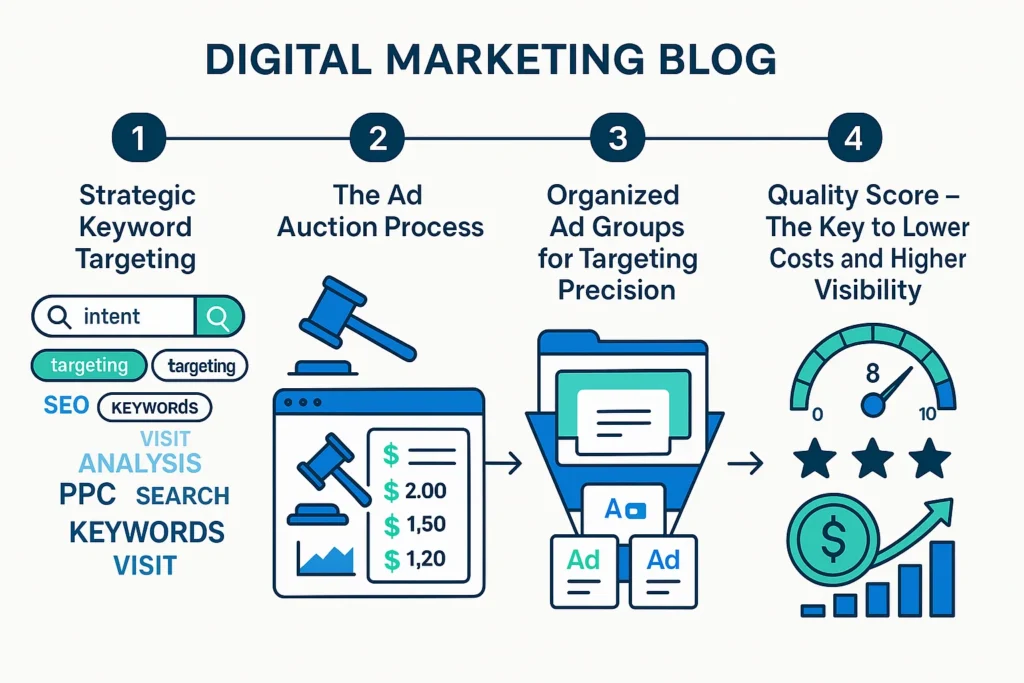
Analyze the Performance of Your PPC Campaign
If you want to know if your PPC is producing results, then concentrate on only these critical factors.
Conversion Rate
This indicates the percentage of users who take your desired action (purchase, call, signup, etc.) after clicking your ad. More conversions mean your ads and landing pages are successfully working to convert visitors into customers.
Click-Through Rate (CTR)
CTR (click-through rate) is the ratio of how often people who see your ad end up clicking it. A high CTR means your ad is both relevant and interesting to the people seeing it. Higher CTR can also increase your Quality Score (QS) and reduce your costs.
Return on Ad Spend (ROAS)
ROAS shows how much revenue you’re earning for every dollar you spend on ads. You can calculate it by dividing your total revenue generated from your PPC campaign by how much you’ve spent on ads. The higher the ROAS, the more profitable your campaign is.

Cost Per Acquisition (CPA)
CPA measures the amount you spend to get a new customer from your ads. Lowering CPA, but still producing high-quality leads, is the key to spending your marketing budget wisely and making a profit.
Quality Score
This is a Google Ads metric that evaluates the relevance and quality of your keywords, ads, and landing pages. You may also find that you get a better ad placement and pay less for the click with Higher Quality Scores, and overall, it makes your campaigns more efficient.
By consistently measuring these metrics, you can identify what’s working, what could work better, and that your PPC campaign is generating tangible business results.
How to develop your PPC strategy

Building a PPC strategy that outshines the rest takes more than just copy-pasting standard tactics. To create a unique and successful PPC methodology, ensure that your campaigns reflect your business objectives, utilize the valuable insight of competitors, and always tweak your strategies against real data.
1. Start with Clear Business Objectives
- Identify what you’re trying to accomplish — maybe it’s lead generation, increasing sales, or spreading brand awareness.
- Customize your PPC campaigns to these objectives by selecting campaign types and ad formats that align with your goals.
2. Deep-Dive Competitor Analysis
- Figure out your biggest competition by searching your keywords and taking notes on who always seems to pop up on the first page.
- Analyze the ad copy, the landing pages, and the offers available.
- Find opportunities tucked into those gaps— things your competitors aren’t saying, niches where they don’t have a unique value proposition, or audiences they might not be considering.
- Use this intelligence to differentiate your message and value proposition.
3. Target Unexplored Opportunities
- Now focus on the keywords and audience segments that your competitors are ignoring, long-tail keywords, or niche demographics.
- Think about other ad formats — video or display ads, that could catch users’ attention in ways your competitors aren’t.
4. Precision Audience Segmentation
- Segment your campaigns by customer journey stage, location, or demographic for appropriate engagement.
- Use lookalike or similar audiences to acquire new users who are similar to your best customers.
5. Create Engaging Ad Copy
- Emphasize what makes your business stand out— special offers, warranties, or services your competitors don’t offer.
- Employ a strong CTA and make sure your ad copy aligns with the intent of the search and the audience’s expectations.
6. Customized, Mobile-Optimized Landing Pages
- Direct ad traffic to a landing page that corresponds to the promise of the ad, not a random homepage.
- Just make sure these pages are fast, easy to use, and mobile-friendly.
7. Set a Data-Driven Budget
- Research CPC and CR benchmarks for your industry to set your budget.
- Allocate spend according to campaign performance and business priorities, and adjust as you collect more information.
8. Test and Optimize Regularly
- Run A/B tests ad headlines, descriptions, images, and landing page elements regularly to find what’s going to make the most of your ad spend.
- Keep an eye on important metrics like conversion rate, cost per acquisition, and return on ad spend, and adjust as necessary based on real numbers.
9. Monitor Competitors and Market Trends
- Keep your head above concerning updates, while also constantly monitoring your industry’s PPC landscape.
- Adapt to new opportunities like trending Keywords or platforms.
10. Measure, Report, and Iterate
- Use analytics tools to monitor campaign performance and tie results to your business objectives.
- Report back on what’s working, and where there’s room for improvement, and adjust on the fly to drive ongoing growth in the most data-driven way possible!
Small Business PPC Tips:
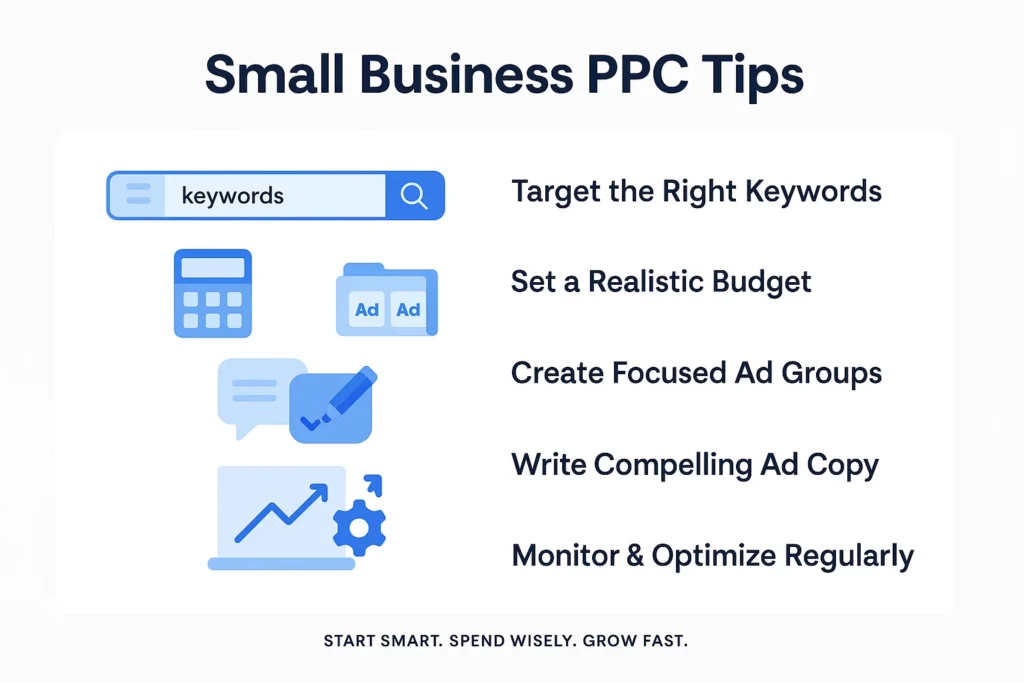
For small businesses, PPC success means understanding your audience, driving local intent, and constantly optimizing your game plan. Be nimble, continue learning from your data, and let your unique story leak into every frame of every ad and landing page.
Pinpoint Your Ideal Audience
Begin by getting crystal clear about the exact people you want to reach. Construct robust customer profiles using information from sales data, feedback from customers, and online analytics. The location, habits, and needs of your target audience can inform how you set up your advertising. The more information you have, the more parts of your budget that work wonders!
Focus on Local and Niche Keywords
Rather than chasing broad, expensive phrases that everyone else is bidding on, concentrate your efforts on specific keywords that serve as accurate, unique representations of your offerings and local market. You can use tools such as Google Keyword Planner, but this can give you all the funds, such as “emergency plumber in [your city]” or “organic bakery near me.” Such a strategy maximizes relevance and minimizes cost.
Create Ads that Speak Directly to Your Audience
Craft persuasive ad copy that calls out your audience’s pain points and makes the case for what makes your business unique. Use your USP and adjust your voice based on your brand persona. Every word should count—be brief, be bold, be compelling.
Optimize Every Landing Page
Make sure to write your landing page to coincide with your ad. Keep your messaging uniform, keep navigation easy, and ensure fast load times. Add trust factors such as reviews or guarantees, and ensure your call-to-action (CTA) is transparent and persuasive.
Protect Your Budget with Negative Keywords
Make sure you air out your negative keyword list to exclude irrelevant searches as you go. This ensures you’re not wasting spend on users who are unlikely to make a purchase, as you can now allocate your budget towards high-intent clicks.
Use Ad Extensions
Add some location, call, or sitelink extensions to your ad. Your ads then show up with these enhancements, giving people both more visibility into your company and extra information like your phone number or an immediate link to a special promotion, all of which make it more likely that someone will engage with your ad.
Maintain Strong Action-Driven CTAs
It’s fine to be straightforward and energetic in your CTAs. Instruct users precisely what you want them to do, whether it’s “Book Now,” “Get a Free Quote,” or “See Today’s Specials.” Make the next step irresistible and easy.
PPC Management Pricing
PPC management pricing costs depend largely on the selected platform, your business size, and your overall campaign complexity.
- Small businesses ($100 – $5,000 a month budgets) who want to invest a small budget every month to maximize their investment in targeted campaigns and ad spends.
- Large businesses, on the other hand ($10,000–$100,000+ per month), typically have the budget to support expansive, multi-channel efforts at scale with broad reach and competition.
Management Fees are often a percentage of ad spend or a fixed monthly rate (with larger fees for larger campaigns, as more time will be needed for oversight, reporting, and optimization). Here are the costs for different platforms:
| Platform | Average CPC (Typical) | Average CPC (Typical) | Small Bussiness Monthly Spend | Large Business Monthly Spend |
| Google Ads | $0.01–$10+ (avg. $5.26) | $0.51–$7 | $100–$5,000 | $10,000–$100,000+ |
| $0.51–$0.58 (avg.) | $8.77–$8.96 | $100–$3,000 | $10,000–$50,000+ | |
| Amazon | $0.80–$2.50 (most types) | $4–$12 | $500–$5,000 | $20,000+ |
| Microsoft (Binge) | $1.24–$2.80 (avg. $1.54–$2.80) | $6–$9 | $100–$3,000 | $5,000–$20,000+ |
| YouTube Ads | $0.02–$0.50 per view (not CPC, but cost per view) | $4–$10 per 1,000 views | $100–$1,000 | $5,000–$50,000+ |
| $0.10–$1.50 | $2–$8 | $500–$2,000 | $5,000–$20,000+ |
The bottom line is this: Good PPC management ensures that every dollar spent provides results, no matter how big the business or the platform.
Is a PPC worthwhile for a small business?
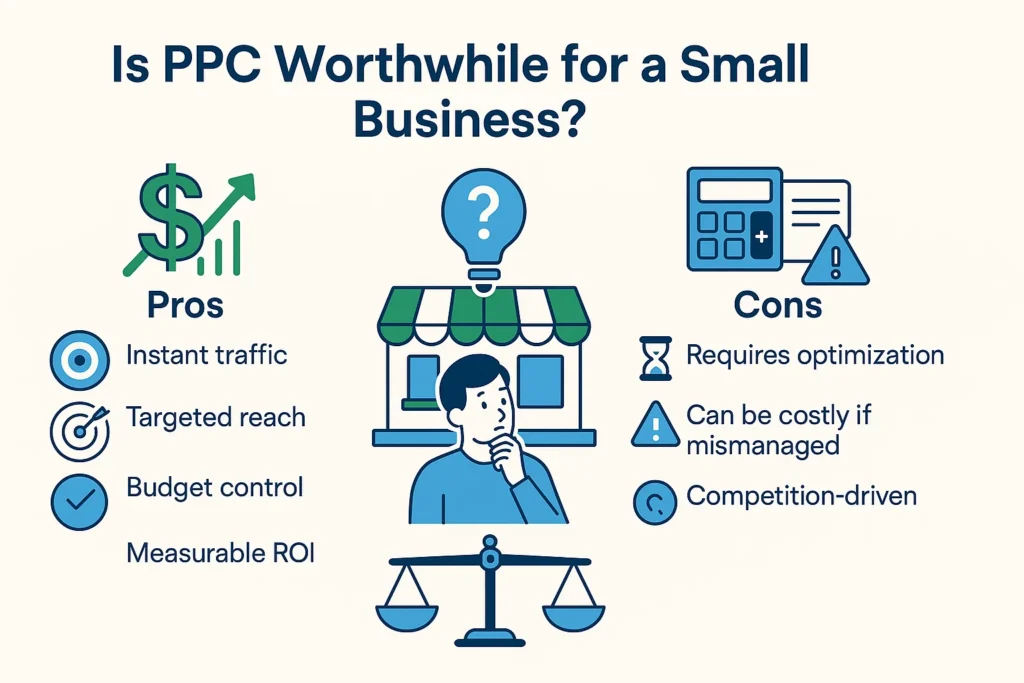
Pay-per-click (PPC) advertising isn’t only for big businesses with massive budgets. PPC is an effective way for businesses of all sizes to drive traffic to their website. If approached correctly, PPC can get you in front of potential customers who are actively searching for what you provide, delivering fast and providing quantifiable results quickly.
Fast Visibility: Organic methods can take months, but PPC gets your business visible immediately. Your ads can appear at the top of search results or in social media feeds, making it possible for you to compete with larger competitors, even if you don’t have a big budget.
Precision Targeting: With PPC, you can concentrate your advertising expenditures on the people most likely to purchase your products. You can target by location, demographics, interests , and even keywords, so your budget is not just wasted on irrelevant clicks.
Budgeting Preferences: Decide how much you want to spend with daily or monthly limits. PPC is available to any size business and lets you dive in without the necessity of spending a fortune to get started.
Measurable Results: Real-time tracking of every click, conversion, and dollar you spend. You can tell exactly what’s working and where you should shift your efforts for more return.
Some visitors won’t buy the first time they visit. Remarketing allows you to simply re-engage with your previous visitors and encourages them along the path to purchase. And this kind of direct follow-up can vastly increase your conversion rates.
Conclusion:
Ready to step up your business with PPC? Begin with the small goals, stay focused on your goals, and continue optimizing your campaigns. No doubt, PPC can be one of your most powerful tools to bring in new customers and grow your brand.
Ready to step up your business with PPC? Consider United Ranker, a leading digital marketing company for proven results. We help businesses of all sizes maximize their online presence through comprehensive digital marketing services. We are here to help you achieve your growth goals and stand out in today’s competitive digital landscape.
FAQs
PPC (Pay-Per-Click) is an online advertising model where you pay the cost every time user clicks your advertisement. PPC can be used to generate leads and sales as it has a specific reach and provides instant traffic, which makes it an effective strategy when it comes to small businesses.
Google Ads, Microsoft Ads (Bing), and social media (Facebook, Instagram, and LinkedIn) are the most popular ones. The best use of Google Ads is its search intent, whereas Facebook and Instagram are the best for demographic and interest targeting.
The typical monthly budget of a small business is between $100 to $5,000, depending on the industry competition and the objectives of the campaign. You control your daily and monthly spending all the way to scale as you achieve results


